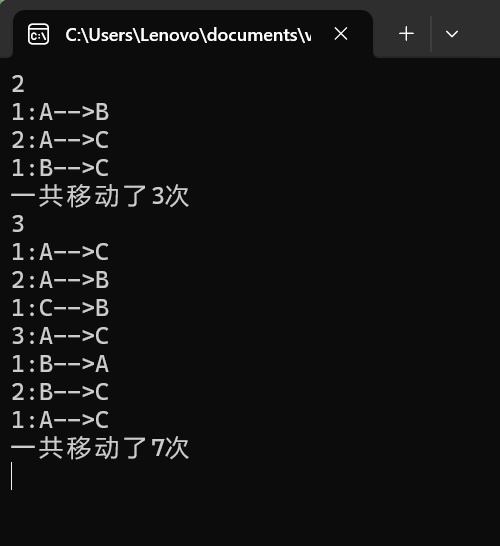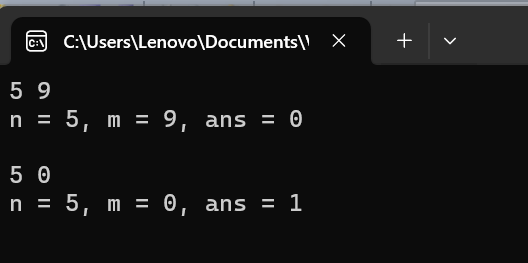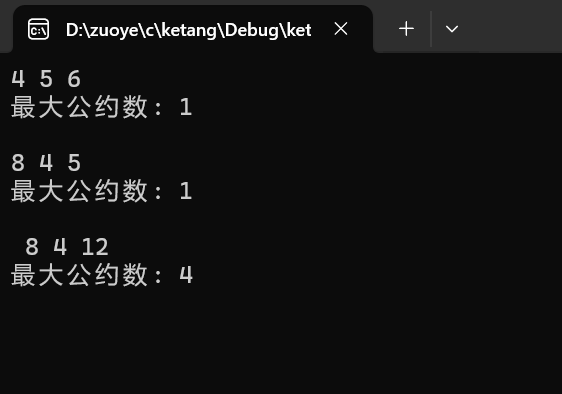实验3
实验任务1
代码
#include
char score_to_grade( int score);
int main() {
int score;
char grade;
while ( scanf ( "%d" , &score) != EOF) {
grade = score_to_grade(score);
printf ( "分数: %d, 等级: %c\n\n" , score, grade);
}
return 0;
}
char score_to_grade( int score) {
char ans;
switch (score/10) {
case 10:
case 9: ans = 'A' ; break ;
case 8: ans = 'B' ; break ;
case 7: ans = 'C' ; break ;
case 6: ans = 'D' ; break ;
default : ans = 'E' ;
}
return ans;
}
图片

问题
1.函数的作用是把分数转化为等级。参数类型是整数,返回值类型是字符。
2.没有break,如果数字大于等于6,它会把下面的部分也执行。例如输入10将会输出“ABCDE”。
实验任务2
代码
#include
int sum_digits( int n);
int main() {
int n;
int ans;
while ( printf ( "Enter n: " ), scanf ( "%d" , &n) != EOF) {
ans = sum_digits(n);
printf ( "n = %d, ans = %d\n\n" , n, ans);
}
return 0;
}
int sum_digits( int n) {
int ans = 0;
while (n != 0) {
ans += n % 10;
n /= 10;
}
return ans;
}
图片

问题
1.计算数字n的各位数字之和。
2.可以。原来的是迭代,改后的是递归。
实验任务3
代码
#include
int power( int x, int n);
int main() {
int x, n;
int ans;
while ( printf ( "Enter x and n: " ), scanf ( "%d%d" , &x, &n) != EOF) {
ans = power(x, n);
printf ( "n = %d, ans = %d\n\n" , n, ans);
}
return 0;
}
int power( int x, int n) {
int t;
if (n == 0)
return 1;
else if (n % 2)
return x * power(x, n-1);
else {
t = power(x, n/2);
return t*t;
}
}
图片

问题
1.函数power的作用是计算x的n次方。
2.是。
n = 0时,power(x,n)=1;
n%2=0时,power(x,n)=power(x,n/2)*power(x,n/2)
n%2≠0时,power(x,n)=x*power(x,n-1);
实验任务4
代码
#include <stdio.h>
#include <stdlib.h>
int prime_is(int n);
int main(){
int i = 0;
int count = 0;
for (i = 3; i <= 98; i++){
if(prime_is(i)==1&&prime_is(i+2)==1){
printf("%d %d\n",i,i+2);
count+=1;}
}
printf("100以内的孪生质数总数为%d",count);
system("pause");
return 0;
}
int prime_is(int n){
int j = 0;
for (j = 2; j < n; j++)
{
if (n%j == 0)
{
return 0;
}
}
return 1;
}
截图

实验任务5
代码
#include <stdio.h>
#include <stdlib.h>
void hanoi(unsigned int n,char from,char temp,char to);
void moveplate(unsigned int n,char from,char to);
int s = 0;
int main() {
unsigned int n;
while(scanf("%u",&n) != EOF){
s=0;
hanoi(n,'A','B','C');
printf("一共移动了%d次\n",s);
}
system("pause");
return 0;
}
void hanoi(unsigned int n,char from,char temp,char to)
{
if(n==1)
moveplate(n,from,to);
else
{
hanoi(n-1,from,to,temp);
moveplate(n,from,to);
hanoi(n-1,temp,from,to);
}
}
void moveplate(unsigned int n,char from,char to)
{
printf("%u:%c-->%c\n",n,from,to);
s++;
}
图片

实验任务6
代码
迭代
#include <stdio.h>
#include <stdlib.h>
int func(int n, int m); // 函数声明
int main() {
int n, m;
int ans;
while(scanf("%d%d", &n, &m) != EOF) {
ans = func(n, m); // 函数调用
printf("n = %d, m = %d, ans = %d\n\n", n, m, ans);
}
system("pause");
return 0;
}
int func(int n, int m){
if(m>n)
return 0;
if (m==0||n==0)
return 1;
int fenzi = 1;
int fenmu = 1;
for(int i=1;i<=m;++i){
fenzi = fenzi*(n-i);
fenmu = fenmu*(m-i);
}
return fenmu/fenzi;
}
// 函数定义
// 待补足。。。(分别用迭代和递归实现)
递归
#include <stdio.h>
#include <stdlib.h>
int func(int n, int m); // 函数声明
int main() {
int n, m;
int ans;
while(scanf("%d%d", &n, &m) != EOF) {
ans = func(n, m); // 函数调用
printf("n = %d, m = %d, ans = %d\n\n", n, m, ans);
}
system("pause");
return 0;
}
int func(int n, int m) {
if (m > n) {
return 0;
}
if (m == 0 || m == n) {
return 1;
}
return func(n - 1, m) + func(n - 1, m - 1);
}
// 函数定义
// 待补足。。。(分别用迭代和递归实现)
图片

实验任务7
代码
#include <stdio.h>
#include <stdlib.h>
int gcd(int a,int b,int c);// 函数声明
// 待补足....
int main(){
int a, b, c;
int ans;
while(scanf("%d%d%d", &a, &b, &c) != EOF) {
ans = gcd(a, b, c); // 函数调用
printf("最大公约数: %d\n\n", ans);
}
system("pause");
return 0;
}
int gcd(int a,int b,int c){
int min;
if(a<=b)
min = a;
else min = b;
if(min>=c)
min = c;
for(int i = min;i>=1;i-=1){
if (a%i==0&&b%i==0&&c%i==0)
return i;
}
}
// 函数定义
// 待补足...
图片

实验总结
1.练习了递归和迭代函数,认识到了这两种的不同。
2.能够定义函数并使用,增强了代码的简易性和可读性。



 浙公网安备 33010602011771号
浙公网安备 33010602011771号